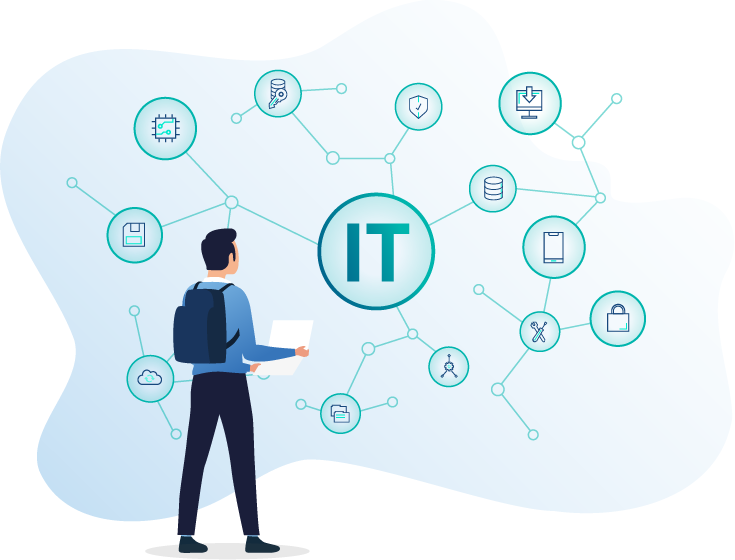BIC Process Design
Understand & Transform
Supercharge your business operations with the most intuitive AI-powered BPM software.
It seems that you come from a German speaking country. Here you can change the language
EnglishDigitalization is reshaping businesses everywhere, moving at an unprecedented pace. IT systems, solutions, standards, and models evolve rapidly—what’s innovative today may become tomorrow’s norm and quickly fall behind. As a cornerstone of modern organizations, IT takes center stage in driving successful digital transformation.

Table of Contents
Author
Markus Kück

Change is the only constant. The market landscape is constantly evolving, driven by technological progress and digital innovations. To successfully navigate the challenges of digitalization, companies must adapt on multiple fronts: streamline existing processes, implement cutting-edge digital solutions, develop new business models, and more. In this transformation, IT plays a pivotal role as both a catalyst and a key enabler of change. IT transformation is not just about optimizing individual systems—it’s about a comprehensive overhaul and modernization of the entire IT landscape to stay ahead in an ever-changing world.

IT transformation (from Latin transformare = to reshape/change) involves reimagining a company’s IT and process landscape to better meet the ever-evolving business needs and technological advancements. The goal is to boost long-term competitiveness and performance. This transformation includes optimizing, modernizing, or replacing existing IT systems, applications, and workflows. As part of this process, the relevance of IT systems and tools is reassessed, and their usage across different departments and locations is carefully analyzed. Factors such as system lifecycles, ongoing and future costs, and updates are scrutinized in detail. Ultimately, IT transformation seeks to streamline the IT landscape, reduce costs, enable a seamless integration of new technologies and drive profit.
Key drivers of IT transformation include:
By leveraging an EAM tool in IT or business transformation, companies gain a clear, multidimensional view of their entire IT landscape. This includes detailed insights into their applications, as well as information on interconnected processes, data, dependencies, and integrated interfaces between applications and IT components. Such transparency is crucial for driving a successful IT transformation.
Get to know BIC EAM Book a demo call

Streamlining IT landscape
Many companies operate multiple IT systems that serve similar or identical functions. By streamlining and optimizing their IT infrastructure, businesses can eliminate redundancies, reduce complexity, and simplify maintenance and support.

Cutting costs
Consolidating IT systems can lead to significant savings in license, maintenance, and operational costs. Additionally, leveraging cloud technologies, AI solutions, and process automation offers further opportunities for cost reduction.

Integrating data
With IT transformation, IT systems, data sources, and processes are no longer viewed in isolation but as interconnected elements, allowing data to be leveraged as a strategic resource.

Improving security concerns
Legacy IT systems often present major security risks with severe consequences. Through the adoption of cutting-edge technologies, businesses can ensure up-to-date security standards and robust protection against cyber threats.

Increasing efficiency and revenue
Upgrading outdated and inefficient IT systems and processes enables companies to optimize, automate, and dramatically accelerate their business operations paving the way for enhanced productivity and increased revenue.

Promoting innovation
A modern IT environment lays the foundation for growth and innovation. Leveraging advanced technologies, companies can accelerate the development of innovative products and services.
While IT transformation brings many benefits, it also presents a range of challenges that must be carefully navigated. A tech startup, for instance, faces different demands and obstacles compared to a decades-old, mid-sized company in the "Old Economy," which may still rely on outdated systems, rigid structures, and entrenched processes. Regardless of the business type, a well-defined strategy and a clear execution plan are essential for a successful IT Modernization. Common challenges often include:
IT transformation involves replacing outdated legacy systems with modern, more efficient solutions. The challenge lies in ensuring flawless interoperability between new and old technologies by integrating them into the existing IT landscape, as well as avoiding the creation of data silos that may hinder the flow of information across systems.
When multiple parties work on IT solutions without close coordination, "shadow IT" can emerge, resulting in fragmented, siloed systems. To avoid this, a successful IT transformation demands seamless collaboration among teams and stakeholders. Effective planning, coordination, and ongoing monitoring of processes and resources are key.
The introduction of new systems is not just a technical upgrade; it’s fundamental that your employees understand, adopt, and integrate them into their daily work. To minimize resistance to change and ease concerns about new technologies and processes, it’s essential to foster open, transparent communication from the start, coupled with comprehensive training programs.
To ensure a smooth technology transformation, it's crucial to safeguard against data loss while also providing robust protection for sensitive information, particularly business and customer data. Implementing the right security measures is essential to protect valuable data throughout the transformation process.
To maximize the benefits of newly implemented solutions, companies need to transform existing processes. This may include eliminating redundant steps, evolving the system landscape, or completely reworking certain processes to align with the new infrastructure.
To effectively tackle the challenges outlined above, business and IT must work more closely together than ever before. A particularly effective approach is combining Business Process Management (from the business perspective) with Enterprise Architecture Management (from the IT perspective). While BPM ensures transparency in business processes, EAM provides insight into the IT landscape. This integrated approach offers a comprehensive view of the enterprise architecture, encompassing both technological and process-related aspects.

Achieving a successful IT transformation demands thorough planning and a well-organized approach. Key steps typically include:
With BIC EAM, you streamline your IT landscape by leveraging an all-in-one suite that harmoniously integrates BPM, process automation, and enterprise architecture management. Experience the power of a holistic approach that drives and accelerates your IT transformation for lasting success. BIC EAM serves as your navigation system through the IT jungle—revealing connections and dependencies, eliminating redundant IT systems, minimizing risks, and enabling scalable growth.


Head of BPM Services
Markus leads the BPM Services department and is responsible for its strategic direction. Together with his team of seasoned specialists, he helps clients optimize their processes sustainably and prepare them for the future. For every need, dedicated experts are on hand to develop tailored solutions that address each client’s unique requirements. With his deep expertise and the collective knowledge of his team, Markus delivers comprehensive, top-tier support for all challenges in business process management.
We have the information you need to unleash your full process potential. Take a look at our resources and start improving your business performance today.